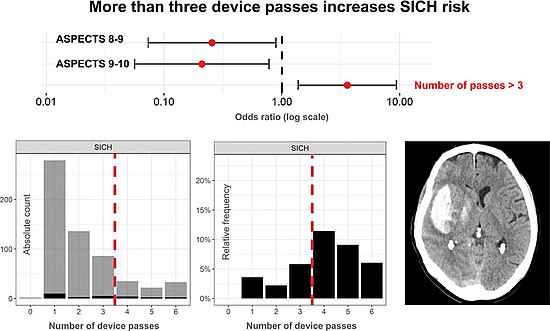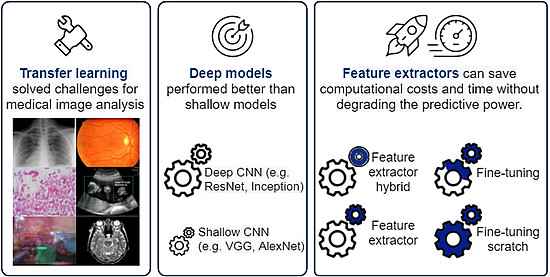Sie befinden sich hier
Inhalt

Neuroradiology & Biomedical Informatics
- Department of Biomedical Informatics (DBMI) at the Center for Preventive Medicine and Digital Health (CPD)
- Department of Neuroradiology (NRAD)
- Co-head of the AG Applied Medical Imaging and Data Science Lab (AMIDL)
Research domains
Applying statistical, machine learning and deep learning models for improved clinical prognostic and predictive modeling in the following clinical domains.
Clinical research focus:
- Neurovascular diseases
- Neurooncology
- Dementia & Neurocognitive disorders
- Reporting
- Translational research (historic/archived)
Bioinformatics focus:
- Information retrieval and ontological mappings of radiological texts
- Multimodal data integration and modeling
- Application of deep learning and foundation models
- Forecasting & resource allocation
- Machine learning on genetic, image and text data
(see publication list no. 1-3) - Prognostic and predictive outcome modeling
(see publication list no. 4-7) - Preventive medicine and forecasting
(see publication list no. 8) - Text analyses, NLP and information retrieval
(see publication list no. 9-10)
Dr. Maros is a board-certified attending radiologist the Department of Neuroradiology. He holds a PhD in digital molecular pathology and a master’s degree in bioinformatics/statistics. He is the head of the Junior Research Group MIDorAI of the MIRACUM Consortium of the German Medical Informatics Initiative (MII) focusing on the development of “Disease models and multimodal synthetic data generation for personalized and preventive medicine” at the Department of Biomedical Informatics (DBMI), Medical Faculty Mannheim (Dr. Fabian Siegel & Prof. Dr. Michael Neumaier).
He is the co-founder and machine learning specialist of our research group (Applied Medical Image & Data Analysis; AMIDL; neurorad.xyz) at the Department of Neuroradiology.
He is interested in tackling everyday challenges that neuro/radiologists face using the power of underlying patterns and math thus improving the quality of care benefitting our patients and community.
Visual abstract summarizing the scope of deep learning models and applications for “Transfer learning for medical image classification: a literature review“ by Kim, H.E. et al., BMC Med Imaging, 2022.

“Number of retrieval attempts rather than procedure time is associated with risk of symptomatic intracranial hemorrhage” by Maros M. E. et al., Stroke. 2021.
National and international joint research projects
Medical Informatics for Holistic Disease Models in Personalized and Preventive Medicine (MIDorAI)
Junior Research Group - MIRACUM Consortium
Duration: 2022–2027, Funding: BMBF.
WEather-based STroke event and Outcome Risk Modeling (WE-STORM)
Duration: 2021–2025, Funding: MIDorAI, MII, BMBF.
Dr. Maros is the PI of the ongoing WE-STORM German Research Data Portal for Health (FDPG) research project, which is performed as part of the Medical Informatics Initiative (MII). The aim of WE-STORM is to validate classical statistical and machine learning models for real-time forecasting to predict the number of stroke admissions based on meteorological patterns.
GeMTeX (German Medical Text Corpus) - Automated indexing of medical texts for research
Duration: 2024–2026, Funding: MII-NUM, BMBF.
The full potential of clinical documents cannot be realised due to a lack of standardisation. The GeMTeX methodology platform aims to fill this gap and make medical texts from patient care available for research projects. The goal is to create the largest medical text corpus in the German language.
We participate as external non-funded partners for text corpus generation.
The Brain Tumor Segmentation (BraTS-METS) Challenge 2023: Brain Metastasis Segmentation on Pre-treatment MRI led by the Yale University School of Medicine.
Duration: 2023–2024, Funding: MIDorAI, MII, BMBF.
Federated Learning for Postoperative Segmentation of Treated glioblastoma (FL-PoST) spearheaded by Duke and Indiana Universities.
Duration: 2024, Funding: MIDorAI, MII, BMBF.
Selected Publications
#Applied Machine & Deep Learning
- Kim HE, Maros ME, Miethke T, Kittel M, Siegel F, Ganslandt T. Lightweight Visual Transformers Outperform Convolutional Neural Networks for Gram-Stained Image Classification: An Empirical Study. Biomedicines, 2023. 11(5):1333. doi: 10.3390/biomedicines11051333.
- Kim HE, Cosa-Linan A, Santhanam N, Jannesari M, Maros ME*, Ganslandt T.* Transfer learning for medical image classification: a literature review. BMC Medical Imaging, 2022. 22(1):69. doi: 10.1186/s12880-022-00793-7. *equal contribution
- Maros ME, Capper D, Jones DTW, Hovestadt V, von Deimling A, Pfister SM, Benner A, Zucknick M, Sill M. Machine learning workflows to estimate class probabilities for precision cancer diagnostics on DNA methylation microarray data. Nature Protocols. 2020. 15(2):479-512. doi: 10.1038/s41596-019-0251-6.
#Stroke prognostic- & predictive modeling
- Centner FS, Oster ME, Dally FJ, Sauter-Servaes J, Pelzer T, Schoettler JJ, Hahn B, Fairley AM, Abdulazim A, Hackenberg KAM, Groden C, Etminan N, Krebs J, Thiel M, Wenz H, Maros ME. Comparative Analyses of the Impact of Different Criteria for Sepsis Diagnosis on Outcome in Patients with Spontaneous Subarachnoid Hemorrhage. Journal of Clinical Medicine, 2022. 11(13):3873. doi: 10.3390/jcm11133873.
- Maros ME, Brekenfeld C, Broocks G, Leischner H, McDonough R, Deb-Chatterji M, Alegiani A, Thomalla G, Fiehler J, Flottmann F; GSR Investigators. Number of retrieval attempts rather than procedure time is associated with risk of symptomatic intracranial hemorrhage. Stroke. 2021. 52(5):1580-1588. doi: 10.1161/STROKEAHA.120.031242.
- Flottmann F, Brekenfeld C, Broocks G, Leischner H, McDonough R, Faizy TD, Deb-Chatterji M, Alegiani A, Thomalla G, Mpotsaris A, Nolte CH, Fiehler J, Maros ME; GSR investigators. Good clinical outcome decreases with number of retrieval attempts in stroke thrombectomy: beyond the first-pass effect. Stroke, 2021. 52(2):482-490. doi: 10.1161/STROKEAHA.120.029830.
# Translational research
- Weyer V*, Maros ME*, Kronfeld A, Kirschner S, Groden C, Sommer C, Tanyildizi Y, Kramer M, Brockmann MA. Longitudinal imaging and evaluation of sah-associated cerebral large artery vasospasm in mice using micro-ct and angiography. J Cereb Blood Flow Metab. 2020. 40(11):2265-2277. doi: 10.1177/0271678X19887052. *equal contribution
#Preventive medicine & forecasting
- Santhanam N, Wen H, …, Groden C, Siegel F, Maros M. Abstract #259. Predicting ischemic stroke admissions based on weather patterns for improved clinical resource allocation using machine learning. DGNR 2023. Clin Neuroradiol 33 (Suppl 1), 1–140 (2023).
#NLP - Natural Language Processing
- Kämpgen B, Sodmann PF, Maros ME, Klüter A. Verstehen was Ärzte schreiben: Kann KI die Datenflut in der Medizin bändigen? In Künstliche Intelligenz im Gesundheitswesen: Entwicklungen, Beispiele und Perspektiven Book Chapter in Wiesbaden: Springer Fachmedien Wiesbaden. pp. 547-564. 2022
- Maros ME, Cho CG, Junge AG, Kämpgen B, Saase V, Siegel F, Trinkmann F, Ganslandt T, Groden C, Wenz H. Comparative analysis of machine learning algorithms for computer-assisted reporting based on fully automated cross-lingual RadLex mappings. Scientific Reports, 2021. 11(1):5529. doi: 10.1038/s41598-021-85016-9.
Photo Credits: #1 FGV-Zentrum, Med. Fakultät Mannheim
Kontextspalte
Contact
Medical Faculty Mannheim
Heidelberg University
Theodor-Kutzer-Ufer 1-3
68167 Mannheim
Phone +49 621 383-2443
mate.maros@medma.uni-heidelberg.de

